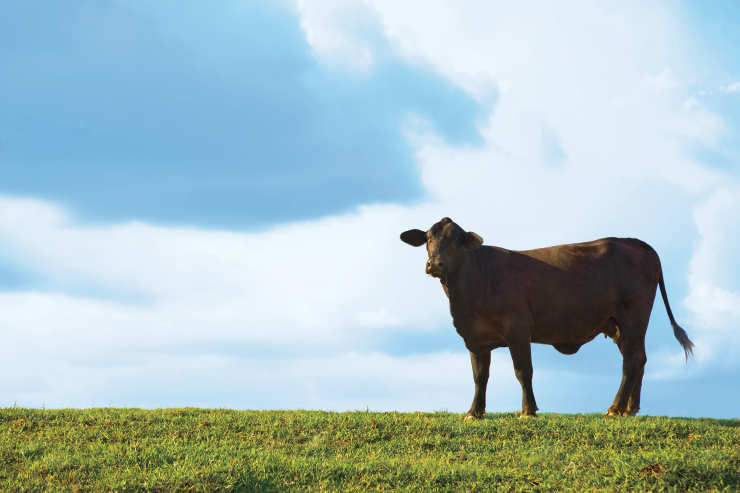Home > Alabama > Alabama Crops & Livestock > Alabama Cattle Producers First Step in High-Quality Beef
Alabama Cattle Producers First Step in High-Quality Beef

Cattle are produced in every county in Alabama, making raising cattle the most widely practiced form of agriculture in the state, and second only to the poultry industry in terms of revenue among all Alabama commodities.
Bill Lipscomb is one of the more than 21,000 cattle producers in the state. He is a fourth-generation cattleman and owns and operates Three L Ranch in Prattville, AL. A 1975 graduate of Auburn University with a degree in agricultural science, Lipscomb also serves as general manager for Autauga Farming Company in Autaugaville. With 100 head of cattle, Three L is part of a network of farms that has more than 1.2 million head in the state.
“I was born into it. Both my father and my grandfather raised cattle,” Lipscomb says. “Three L is a family farm in partnership with my sisters and my mother.”
Like most Alabama cattlemen, Lipscomb’s operation is considered the first step in the beef production process. He maintains a breeding herd of cows that birth calves every year. Alabama has some of the top purebred herds in the country. These outstanding seedstock producers supply a large selection of outstanding bulls annually, representing all of the major breeds from Angus to Limousin. Cattlemen like Lipscomb across the southeastern United States work about 25 percent of the nation’s cow herd.
Beef calves are weaned between 6 and 10 months of age and are most often sold in Alabama’s robust network of livestock auction markets. The market weight of the calves has been steadily improving thanks to advancements in animal science and genetics.
“We are now seeing 500-800 pound cows that have been weaned and preconditioned for two months,” says Dr. William Powell, the executive vice president of the Alabama Cattlemen’s Association. “In the past those cows would weigh 350-450 pounds.”
Improved genetics, nutrition and management have produced healthier and heavier beef cattle in the state, and these larger cattle are producing beef that is much leaner and more nutritious, Dr. Powell says.
“The way we handle cattle has changed,” Lipscomb says. “Through educational efforts from the National Cattlemen’s Association and others, we’ve learned a lot about feed quality and nutrition. We pay more attention to what we do and how we do it, and there are a lot more products and information on the market to help us.”
Alabama Cattlemen’s Association President Donna Jo Curtis of Athens, Ala., also praises the genetic and nutritional advancements. Curtis was helping her father raise cows when she was a child and has been running her own cow/calf operation with her husband for the past 31 years.
“We are taking calves to market anywhere between 700 and 800 pounds, which is much heavier than we were producing 20 years ago,” Curtis says. “The genetics research helps us pick bulls that have depth and muscle, and we get calves that are long and thick with good muscle, but not fat or fleshy,” she says. “All that is important because we are selling pounds and quality to the buyers.”
Selling the calves is typically the end of the cycle for Alabama cattlemen, who turn their attention to the next round of births due just a few months after calves go to market. In 2011, Alabama cattle producers sold nearly $400 million worth of cattle and calves. At the beginning of last year, the total value of cattle on farms in the state was $873 million. The value per head was $710 – a $40 increase from 2010. The industry generates about $2.5 billion in the state.
“It’s a good time to be in the cattle business in Alabama,” Curtis says.
Buyers ship many of the calves to wheat fields in Oklahoma or Kansas where they move into a new growth phase until the animals reach about 900 pounds. At that point they go to a feedlot or feedyard in that same region where they receive higher concentrated feeds and health maintenance until they hit a market weight ranging from 1,200 to 1,400 pounds.
“Probably one of the biggest changes I’ve seen is the way we finish the cattle,” Lipscomb says. “Truckloads of cattle leave here to go to feedlots somewhere in the Midwest to get ready for market.”
The next step is processing in a USDA-approved facility, which produces the final beef products for domestic and global consumers. Worldwide demand has opened new markets for U.S. beef producers, with 2011 setting a new export record of 2.35 billion pounds of beef shipped overseas. The 2012 figures are expected to increase.
Dr. Powell says part of Alabama’s success in the cattle industry is due to the cattle producer’s commitment to their products.
“Here in Alabama, we were among the first to participate in the Beef Checkoff program, where a cattle producer pays a dollar when they sell their animals,” he says. “That money is pooled nationally to pay for research on beef, to advertise beef, to provide educational information and to promote our products. It has proved quite positive for our cattle industry in building consumer confidence and building demand for quality products.”



